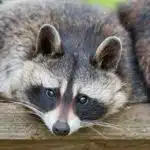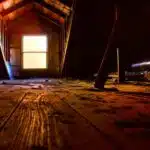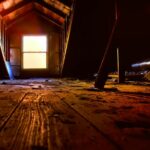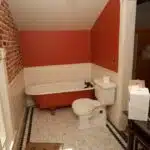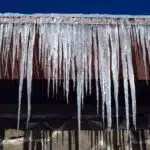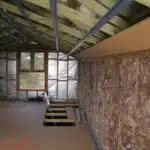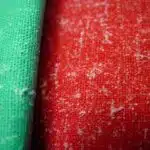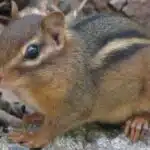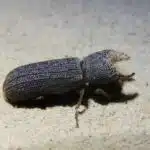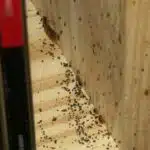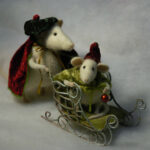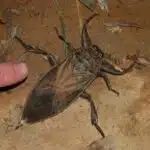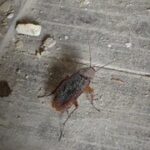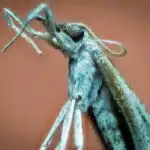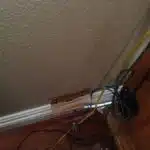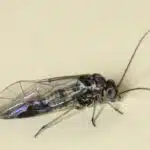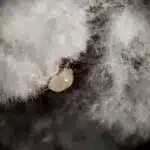Raccoons are a common pest found in many homes, especially in North America. They are known to invade attics and cause significant damage to property. Raccoons can create nests, chew through wires, and leave their droppings all over the place. Dealing with raccoons in your attic can be a frustrating experience that requires expert knowledge and patience.
As a pest control expert, I have seen my fair share of raccoon infestations. These furry critters can be quite challenging to deal with, but it’s not impossible to get rid of them. In this article, we will discuss some effective tips on how to remove raccoons from your attic safely and humanely. Whether you’re dealing with one or multiple raccoons in your home, these proven methods will help you eliminate them for good so that you can enjoy a peaceful and healthy living environment once again.
Identifying The Signs Of A Raccoon Infestation
To effectively get rid of raccoons in your attic, it is important to first identify whether or not you actually have an infestation. Raccoons are notorious for their ability to cause damage and create a mess, so it is crucial to be on the lookout for signs that they may be present in your home.
Identifying raccoon habits can help you determine whether or not these critters are inhabiting your attic space. Raccoons are nocturnal creatures and tend to be most active during the night when they venture out in search of food. If you hear scratching or rustling sounds coming from your attic during the nighttime hours, this could be a sign that raccoons are present.
Another key factor to consider when identifying a raccoon infestation is their entry points. Common entry points for raccoons include damaged roof vents, loose shingles or siding, and unsecured windows or doors. By keeping an eye out for these types of vulnerabilities in your home’s exterior, you can take proactive steps to prevent future infestations and effectively manage any current ones.
By understanding raccoon behavior and being able to identify signs of an infestation, homeowners can take proactive measures towards getting rid of these pests once and for all. In the next section, we will dive deeper into understanding what motivates raccoons and why they may have chosen your attic as their new home.
Understanding Raccoon Behavior
Raccoons are nocturnal creatures, which means they are active mostly at night. They prefer to rest during the day and will find a quiet and dark place to sleep in. This makes attics an attractive spot for them as it provides a safe and secure environment for them to rest. Understanding raccoon behavior is crucial when trying to get rid of them from your attic.
Diet preferences of raccoons vary depending on the season and location. In urban areas, they tend to have a more diverse diet, including garbage, pet food, vegetables, fruits, and insects. However, their preference for food changes with the time of year; during spring and summer months, they eat more insects and other invertebrates while consuming more nuts and berries during fall months.
Raccoons can be challenging to remove from your attic as they are intelligent creatures that adapt quickly to their surroundings. It is essential to understand their behaviors before attempting any removal methods. Knowing their nocturnal habits and diet preferences can help you develop strategies that will effectively deter them from your property without causing harm or distress.
Understanding raccoon behavior is only the first step in getting rid of them from your attic. The next step is assessing the extent of the infestation so that you can determine what actions need to be taken for effective removal.
Assessing The Extent Of The Infestation
Before taking any steps to remove raccoons from your attic, it is important to assess the severity of the infestation. This will help you determine the best course of action and ensure that you are able to fully eliminate the problem. There are a few key signs that can indicate a raccoon infestation, including strange noises in your attic at night, damage to insulation or wiring, and strong odors.
If you suspect that you have a raccoon infestation in your attic, it is important to seek professional consultation. A pest control expert will be able to properly assess the extent of the infestation and recommend an effective treatment plan. They may also be able to identify any points of entry that need to be sealed off in order to prevent future infestations.
Keep in mind that attempting to remove raccoons from your attic on your own can be dangerous and ineffective. It is always best to consult with a professional who has experience dealing with these types of pests. By assessing the severity of the infestation and seeking professional consultation, you can take the first step towards eliminating raccoons from your attic for good.
Transition: After assessing the extent of the infestation and consulting with a pest control expert, it’s time to move on to securing your attic against future intrusions.
Securing Your Attic
Picture a fortress, with its walls and gates keeping the enemy out. Your attic is no different, as it serves as your home’s defense against the outside world. But what happens when uninvited guests like raccoons breach those walls? Their presence can compromise the safety of your home and its inhabitants, as they can cause damage to insulation and wiring. Therefore, securing your attic against these pests is crucial.
One effective way to secure your attic is by replacing damaged or soiled insulation. Raccoons are known for their tendency to defecate in places where they sleep and eat, which can lead to contamination of insulation material. This contamination not only poses health risks but also attracts other pests that feed on feces. Insulation replacement ensures that any contaminated material is removed and replaced with new, clean insulation.
Another crucial aspect of securing your attic is ventilation modification. Poor ventilation can create an ideal breeding ground for raccoons, as it provides warmth and moisture that they need to thrive. Proper ventilation ensures that your attic stays dry, making it less attractive to these pests. It also helps control temperature levels in the space, which can reduce energy consumption and save you money in the long run.
Securing your attic against raccoons involves more than just sealing entry points or using repellents. It requires a comprehensive approach that addresses all aspects of pest infestation control – from insulation replacement to ventilation modification. By doing this, you will ensure that your fortress remains impenetrable against these pesky invaders.
Moving forward into trapping raccoons safely and humanely requires careful planning and execution.
Trapping Raccoons Safely And Humanely
After securing your attic, it is time to focus on removing the raccoons that have already made a home there. Trapping is the most effective method for this, but it requires proper techniques and ethical considerations.
Trapping techniques vary depending on the type of trap used. Live traps are the most humane option, as they allow you to release the raccoon back into the wild without harming it. However, these traps require daily monitoring to prevent undue stress or harm to the animal. Snap traps are another option, but they can be dangerous and should only be used by experienced professionals. It is important to follow all manufacturer instructions and local regulations when trapping raccoons.
Ethical considerations must also be taken into account when trapping raccoons. The goal should always be to remove them safely and humanely without causing unnecessary harm or distress. It is important to check local regulations before trapping any wildlife, as some areas may require permits or have specific guidelines for trapping and releasing animals.
- Properly baiting traps with food that will attract raccoons.
- Checking traps regularly to avoid undue stress or harm to trapped animals.
- Releasing trapped animals in a safe location away from residential areas.
- Checking local regulations regarding trapping and releasing wildlife.
- Seeking professional assistance if unsure about proper trapping techniques.
Trapping raccoons can be a delicate process that requires patience, care, and attention to detail. By using proper techniques and considering ethical considerations, you can safely remove unwanted raccoons from your attic. In the next section, we will discuss how repellents and deterrents can help prevent future infestations without causing harm to these intelligent creatures.
Using Repellents And Deterrents
One effective way of deterring raccoons from entering your attic is by using natural repellents. These are substances that emit a strong odor or taste, which raccoons find unpleasant. Some commonly used natural repellents include vinegar, peppermint oil, and predator urine. By spraying these repellents in and around your attic, you can create an environment that is uninviting to raccoons.
However, it is important to note that while natural repellents may work for some time, they are not a foolproof solution. Raccoons are intelligent animals and can quickly adapt to new scents or tastes. Therefore, it is recommended to use other deterrent methods in combination with natural repellents. This includes sealing all entry points into your attic and removing any food sources.
If the above methods do not work, it may be time to consider hiring exterminators. Pest control experts have access to more potent deterrents and can help identify and seal off all possible entry points into your attic. Additionally, they can safely remove any raccoons that may already be living in your attic without causing harm to the animal or endangering yourself or your family.
Using natural repellents and hiring exterminators are two effective ways of deterring raccoons from entering your attic. However, if these methods do not work, it may be necessary to take more drastic measures such as removing raccoon nests and droppings in order to fully eliminate the problem.
Removing Raccoon Nests And Droppings
Raccoons tend to create their nests in the attic, which can cause significant damage to your property and pose a health risk. Removing raccoon nests is a crucial step in getting rid of these pesky animals. Nests are typically composed of twigs, leaves, and other debris, providing a comfortable environment for raccoons to live in. To remove the nest, it’s best to hire a professional pest control service that has experience in handling such situations.
Once the nest has been removed, it’s time to sanitize your attic thoroughly. Raccoon droppings contain harmful bacteria that can cause serious diseases, including leptospirosis and salmonella. Therefore, it’s essential to clean up all droppings and disinfect the area with an appropriate solution. Avoid using bleach as it doesn’t effectively kill the bacteria present in raccoon feces.
Sanitizing your attic is a crucial step in ensuring that your home is free from any potential health hazards caused by raccoon infestations. A professional pest control service will have the necessary equipment and expertise to clean up thoroughly without causing any further damage to your property or risking exposure to dangerous pathogens.
Transition: Now that you’ve successfully removed the raccoon nests and sanitized your attic, it’s time to take preventive measures to avoid future infestations.
Preventing Future Raccoon Infestations
Having successfully removed the raccoon nests and droppings from your attic, it is now time to focus on preventive measures and long-term solutions to avoid future infestations. As the saying goes, prevention is better than cure. In order to prevent raccoons from entering your attic again, you need to identify and seal off all potential entry points.
Start by inspecting your roof, walls, vents, and other openings that lead into your attic. Any gaps or holes need to be sealed off with durable materials such as metal screening or galvanized steel flashing. Ensure that all windows are tightly shut and locked at night and install motion-activated lights in your yard to deter nocturnal animals such as raccoons.
Long-term solutions include keeping your property clean and uncluttered so as not to attract wild animals looking for food or shelter. This means securing trash cans with tight-fitting lids and storing pet food indoors. Additionally, trimming tree branches that touch your roof will discourage raccoons from using them as bridges onto your house.
In conclusion, taking preventive measures along with implementing long-term solutions will safeguard your home from future raccoon infestations. However, if you do find yourself dealing with a persistent raccoon problem despite these efforts, it may be time to consider hiring a professional wildlife control service for expert assistance in controlling the situation.
Hiring A Professional Wildlife Control Service
- When considering hiring a professional wildlife control service, it is important to research available services and choose one that is experienced and licensed.
- Professional control services can provide humane removal and exclusion of wildlife to ensure safety, health and legal compliance.
- Expert wildlife control services can also identify entry points and provide advice on how to prevent future invasions.
- Professional wildlife control services also offer additional services such as repair and clean-up which can be beneficial for long-term control and prevention.
Choosing The Right Service
When it comes to choosing the right service for wildlife control, it is important to consider a number of factors. A top priority should be finding a reliable service that has experience dealing with raccoons in attics. This means researching potential companies and reading reviews or customer feedback to ensure their effectiveness.
Another important consideration is cost-effective solutions. While it may be tempting to go with the cheapest option, this could end up costing more in the long run if the problem is not fully resolved. Look for a company that offers a fair price for their services and includes follow-up visits to ensure the raccoons are completely eradicated from your attic.
Ultimately, hiring a professional wildlife control service can save homeowners time, money, and stress in dealing with raccoon infestations. By choosing a reliable and cost-effective service, homeowners can rest assured that their attic will be properly cleaned and secured against future intrusions without breaking the bank.
Advantages Of Professional Help
Hiring a professional wildlife control service to handle raccoon infestations in your attic has numerous advantages. For one, professionals have the necessary expertise and training to effectively remove the animals from your property. They are equipped with the right tools and techniques to safely capture and relocate the raccoons without causing harm or damage to your home.
Another benefit of hiring professional help is cost-effectiveness. While DIY methods may seem more affordable at first glance, they often require multiple attempts before successfully resolving the issue. This can end up costing homeowners more money in the long run. On the other hand, professional wildlife control services offer comprehensive solutions that address all aspects of raccoon removal and prevention for a fair price.
Moreover, hiring a professional wildlife control service saves homeowners time and effort. Instead of spending hours researching methods and products, setting traps, and checking them regularly, homeowners can simply call in experts who will handle everything from start to finish. This leaves homeowners free to focus on other important tasks while having peace of mind knowing that their raccoon problem is being taken care of by experienced professionals.
Legal Considerations For Raccoon Removal
When addressing raccoon infestations in your attic, it is crucial to consider not only the physical removal of the animals but also the legal requirements and ethical considerations surrounding their removal. In most states, raccoons are classified as game animals and therefore come under protection laws. These laws govern when and how you can remove them from your property. It is essential to research your state’s specific regulations before attempting any DIY removal methods.
Ethical considerations must also be taken into account when dealing with raccoon removal. These include considering non-lethal alternatives such as live trapping and relocating the animal to a suitable habitat away from residential areas. Moreover, it is important to recognize that raccoons are sentient beings that experience pain, fear, and distress just like humans. Therefore, it is essential to employ humane methods of removal while avoiding causing unnecessary harm or suffering.
To ensure compliance with legal requirements and ethical considerations surrounding raccoon removal, consider hiring a professional pest control company with expertise in handling wildlife species. They have knowledge of applicable laws, permits required for relocation or euthanization, and proper techniques for safe animal handling. Furthermore, they can advise on preventive measures to avoid future infestations.
- As cute as they may seem, raccoons can cause extensive damage to homes by chewing through wiring and insulation material.
- The risk of diseases spread through contact with raccoon droppings can pose significant health risks to occupants of the home.
- Raccoon infestations can lead to a decrease in property value due to structural damage caused by their activity.
- The presence of raccoons in your attic can cause emotional distress as homeowners feel violated by wildlife invading their personal space.
Moving forward into addressing health risks associated with raccoon infestations…
Health Risks Associated With Raccoon Infestations
To prevent the spread of disease associated with raccoon infestations, it is important to take all the necessary precautions to prevent the animals from entering your home or property in the first place.
One way to do this is to make sure all garbage is securely stored and that all possible entry points such as attics, chimneys, and vents are sealed off.
Raccoon infestations can lead to the spread of bacteria and parasites, which may cause serious health risks, such as rabies, leptospirosis, and salmonella.
If an infestation is already present, it is important to seek the help of a professional pest control service to safely remove the animals and decontaminate the area.
Prevention Of Diseases
Preventing raccoon borne illnesses is crucial in ensuring the health and safety of your household. Raccoons are common carriers of zoonotic diseases, which are infectious diseases that can be transmitted between animals and humans. These diseases can cause severe sickness and even death if left untreated. Therefore, it is essential to take preventative measures to avoid any possible contact with raccoon droppings or urine.
Understanding zoonotic diseases is a significant step towards preventing their spread. Some of the most common raccoon-borne diseases include leptospirosis, salmonella, and rabies. These diseases spread through contact with contaminated surfaces such as floors, walls, and insulation materials in attics. It is critical to wear protective gear when handling materials that may have been contaminated by raccoons.
To prevent the spread of disease from raccoons in your attic, you should call a professional pest control company immediately. They will conduct an inspection to identify any entry points and safely remove the animals using humane methods. Additionally, they will sanitize your attic to eliminate all traces of droppings or urine that may have been left behind by the raccoons. This ensures that your family remains safe from any potential harm associated with these animals.
In conclusion, preventing raccoon-borne illnesses requires an understanding of zoonotic diseases and taking preventive measures such as wearing protective gear when handling contaminated materials or calling a professional pest control company for safe removal of these animals from your attic. Protecting yourself against these risks is essential for maintaining good health and avoiding potential health complications caused by these infectious diseases.
Risks Of Transmission
Understanding the transmission risks associated with raccoon infestations is crucial in protecting one’s health. Raccoons are known carriers of several zoonotic diseases that can be transmitted to humans through direct or indirect contact. These diseases pose significant health hazards and can result in severe illness or even death if left untreated. Therefore, it is essential to take appropriate measures to prevent their spread.
One of the primary risks of transmission associated with raccoon infestations is the direct contact with their droppings, urine, and saliva. These bodily fluids may contain harmful bacteria and viruses that can cause diseases such as leptospirosis, salmonella, and rabies. Additionally, indirect contact with contaminated surfaces such as insulation materials in attics can also lead to infection. It is important to note that these illnesses may not manifest immediately but could develop over time.
To minimize the risk of transmission from raccoon infestations, it is best to seek professional pest control services immediately. Professional pest control experts have the necessary knowledge, experience, and equipment to safely remove raccoons from one’s property without causing harm to them or humans. They also have access to specialized cleaning agents that can effectively sanitize contaminated areas and eliminate any potential sources of infection. By taking swift action against raccoon infestations and following preventive measures recommended by experts, individuals can protect themselves from potential health hazards associated with these animals.
Cleaning And Disinfecting Your Attic
“Cleanliness is next to godliness” as the old adage goes, and keeping your attic clean and disinfected is essential to preventing future raccoon infestations. Raccoons are notorious for leaving behind feces and urine in their wake, which can cause significant health risks for you and your family. In this section, we will discuss how to properly clean and disinfect your attic after removing raccoons from your space.
Before beginning the cleaning process, it’s important to wear protective gear such as gloves, a mask, and goggles to prevent exposure to harmful bacteria or viruses. Next, remove all contaminated insulation from your attic using proper techniques according to local regulations. Once all contaminated materials have been removed, use DIY cleaning techniques such as vinegar or bleach solutions to thoroughly clean all surfaces.
After disinfecting the area with a cleaning solution, it’s time to replace any contaminated insulation. Attic insulation acts as a barrier between the elements outside and the living space inside while also providing energy efficiency benefits. Replacing any damaged insulation not only improves air quality but can also save you money on energy bills in the long run.
| Attic Cleaning Checklist | | — | — | — | — | — | | Wear Protective Gear | Remove Contaminated Insulation | Clean Surfaces with DIY Solution | Replace Damaged Insulation | Disinfect Entire Area |
As you can see from the checklist above, cleaning your attic after removing raccoons is an involved process that requires attention to detail. By following these steps and utilizing DIY cleaning techniques, you can ensure that your attic is left clean and disinfected for years to come. In our next section, we will discuss ways in which you can repair any damage caused by raccoons in your attic.”
Repairing Raccoon Damage To Your Attic
After successfully removing raccoons from your attic, it’s crucial to repair the damages they have caused. Raccoons are notorious for tearing through insulation, chewing on wires and pipes, and leaving their feces and urine behind. These damages can lead to costly repairs if not addressed promptly.
The first step in repairing damages caused by raccoons is to assess the extent of the damage. Inspect your attic thoroughly, looking for any holes or gaps they may have created in your roof or walls. Once identified, these openings should be sealed off immediately to prevent re-entry by other pests. Next, remove any soiled insulation that has been contaminated by raccoon waste and replace it with fresh insulation.
Replacing insulation can be a daunting task, especially if you’re not familiar with attic maintenance. It’s recommended that you hire a professional pest control company to handle this job as they have the necessary equipment and expertise to do it efficiently and safely.
- Replacing damaged insulation will improve indoor air quality.
- Repairing damages will help prevent future infestations.
- Proper cleanup will ensure safety for inhabitants and pets.
In conclusion, repairing raccoon damage is crucial after successfully removing them from your attic. Insulation replacement is a vital part of this process as it promotes healthy living conditions while preventing future infestations. By hiring a professional pest control company, you can ensure that your repairs are done correctly and safely while educating yourself on raccoon conservation practices.
Educating Yourself On Raccoon Conservation
After successfully repairing the damage caused by raccoons in your attic, it is crucial to educate yourself on raccoon conservation. Raccoons are fascinating creatures that play an essential role in our ecosystem. These animals are omnivorous and eat insects, fruits, vegetables, and small animals. They are also excellent climbers and swimmers.
Conservation education involves learning how to live with wildlife while providing habitat protection for these animals. Habitat destruction and fragmentation have significantly impacted raccoon populations in urban areas. As a result, it is vital to create suitable habitats that mimic natural environments where raccoons can thrive without causing harm or damage to human property.
Habitat protection includes providing food sources, water sources, and shelter for these animals. Planting native vegetation and creating a wildlife garden can provide adequate food sources for raccoons while promoting biodiversity in your yard. Providing access to clean water sources such as bird baths can also help support wildlife populations in your area. By taking these steps towards conservation, you can coexist with raccoons in harmony while protecting the environment around you.
Living in harmony with wildlife requires effort on our part to understand and appreciate the importance of coexisting with other species on this planet. It is essential to recognize that we share this world with millions of other living creatures that play a critical role in maintaining a healthy ecosystem for all of us. By educating ourselves on conservation efforts and providing habitat protection for raccoons and other wildlife species, we can promote biodiversity while preserving our natural resources for future generations to enjoy.
Conclusion: Living In Harmony With Wildlife
Wildlife is an essential part of our ecosystem, and it plays a crucial role in maintaining the balance of nature. Raccoons, along with other animals like possums and squirrels, are often found in residential areas and can cause problems for homeowners. However, it is important to remember that these animals are not pests but wild creatures trying to survive in an urban environment.
Living with wildlife means finding a balance between human needs and the natural world around us. It is possible to coexist with raccoons and other animals without causing harm or inconvenience to either party. One way of doing this is by taking preventive measures such as securing garbage cans, blocking entry points into homes, and removing potential food sources like bird feeders.
In conclusion, living in harmony with wildlife requires us to be mindful of our actions and their impact on the environment. By making a few simple changes to our daily routines, we can create a safe and healthy environment for ourselves and the animals that share our space. Balancing human needs with the needs of wildlife is not always easy, but it is necessary if we want to preserve the natural world for future generations.
Conclusion
Raccoon infestations in attics are a common problem that can cause significant damage to homes. Identifying the signs of an infestation and understanding raccoon behavior are essential in devising effective strategies to control the situation. Securing your attic against future invasions and trapping raccoons safely and humanely are crucial steps towards eliminating raccoons from your attic.
Cleaning and disinfecting your attic after removing the raccoons is necessary to prevent the spread of diseases and eliminate any lingering odors. Repairing any damages caused by the raccoons will help prevent future infestations. Educating yourself on raccoon conservation is also important, as these animals play a vital role in our ecosystem.
One anticipated objection to controlling raccoon populations would be animal rights concerns. However, it is important to remember that controlling their population in urban areas is necessary for both human safety and animal welfare. Living in harmony with wildlife means considering the needs of both humans and animals, including preventing property damage, minimizing disease transmission risks, and promoting conservation efforts for all species. As pest control experts, we prioritize safe, humane, and effective methods for managing raccoon infestations while also respecting the importance of wildlife conservation.
Image Credits
- “Relaxed raccoon” by Tambako the Jaguar (featured)


